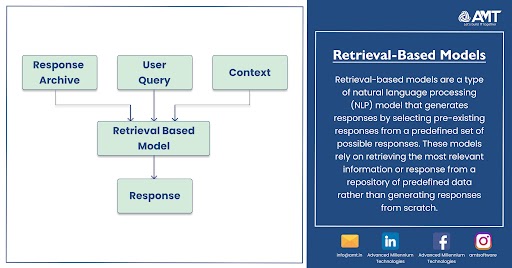Retrieval-based models are a type of natural language processing (NLP) model that generates responses by selecting pre-existing responses from a predefined set of possible responses. These models rely on retrieving the most relevant information or response from a repository of predefined data rather than generating responses from scratch.
Key components and characteristics of retrieval-based models include:
- Response Repository: Retrieval-based models operate with a predefined set of responses or information. These responses are typically stored in a knowledge base or database.
- Matching Mechanism: The model uses a matching mechanism to find the most relevant response from the repository based on the input query. This matching can involve techniques like cosine similarity, semantic similarity, or other similarity metrics.
- Limited Creativity: Unlike generative models that can create entirely new responses, retrieval-based models are constrained by the predefined set of responses. They lack the ability to generate novel answers beyond what is present in their response repository.
- Efficiency: Retrieval-based models can be computationally more efficient compared to generative models, as they don’t need to generate responses from scratch. The response is selected directly from the existing set.
- Use Cases: These models are often used in scenarios where a well-defined set of responses is available, and the goal is to provide accurate and contextually relevant answers. Common use cases include question-answering systems, chatbots, and information retrieval systems.
Examples of retrieval-based models include rule-based systems, information retrieval models, and more advanced methods like neural network-based models with attention mechanisms for better context understanding.
Despite their efficiency in certain scenarios, retrieval-based models have limitations. They may struggle with handling out-of-domain queries or generating responses for questions not present in their training data. Generative models, on the other hand, have the potential for more creativity and adaptability but may require more computational resources and training data. The choice between retrieval-based and generative models depends on the specific requirements and characteristics of the application.
